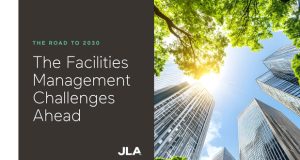 Sunil Shah, Director at Acclaro Advisory & SFMI says the latest FM progress report on sustainability illustrates why the sector must adopt a progressive business model with sustainability at its centre
Sunil Shah, Director at Acclaro Advisory & SFMI says the latest FM progress report on sustainability illustrates why the sector must adopt a progressive business model with sustainability at its centre
The sudden, catastrophic emergence of COVID-19 generated the most significant disruption to life in the post-war era. The pandemic dealt a harsh blow, forcing organisations across the public and private sector to make drastic changes to their operations, commercial models, workplace strategies, employee engagement efforts, health and safety procedures, and more. The SFMI(1), running since 2013, is a sustainability roadmap for the FM sector, helping to benchmark an organisation’s performance against peers and providing a tailored programme of measures that need improvement.
The latest findings provide some guidance on how FM has progressed in meeting sustainability targets during the disruption, but what is clear is that organisations have relied on the facilities management sector to guide them through the pandemic. As existing contracts were torn up, FM demonstrated its responsiveness, flexibility and ability to gain trust, and it has often been the people in low-paid facilities roles that have borne the brunt, risking their health during the crisis.
Investors are also looking at how organisations have responded to the pandemic; in particular their engagement with staff, the resilience of service offerings and the adaptability of the management team. The rise of Environment, Social and Governance (ESG) measures now require a greater level of public disclosure, based upon the collection and analysis of data and a clear forward strategy. With many of these impacts, including supply chain diversity, carbon emissions, and waste efficiency affecting the facilities operations, a robustness over data, risks and decision making is a necessary part of the role.
VIEW FROM THE SUSTAINABLE FM INDEX
Looking ahead to the long-term view, the pandemic has accelerated a shift in working habits, forced organisations to undertake home working and enabled discussions about remote working to take place. While organisations will all have their specific requirements, an increased level of flexibility in working patterns is expected, with the role of the office becoming increasingly a place to meet and connect – exemplifying the brand and relationships of the business.
So, what does this mean for FM and its long-term approach to sustainability? Its newfound responsibilities during the pandemic enabled the sector to assume a strategic position that it struggled to attain in the past. Our 2020 SFMI audits(i) found evidence of FM service providers integrating sustainability into their service offering and working in partnership with customers to transform their sustainable outcomes.
However, while leaders are progressing, the audits revealed that a significant number of the FM sector remain desperately unequipped to meet the increasingly critical sustainability challenges. Ultimately, this will pose a problem for organisations who need to meet these public targets, from reducing carbon to building a more equal society.
FM organisations must maintain the high level of engagement they now enjoy with leadership teams and cement this new business normal. The pandemic, together with climate change, rising economic inequality and a growing social justice movement, represents the perfect storm for FM to reinforce its status as an agent for change. The alternative is a reversion back to the Cinderella profession that does the dirty work and never goes to the ball.
SFMI 23 CRITERIA
The role of FM in sustainability is an important one, so a key discussion point should be around how FMs can measure customer benefits and the added value they provide. This includes identifying the opportunities raised and the achievements delivered from both a qualitative and a quantitative perspective.
The SFMI assessment is made against 23 criteria, captured under broad Environmental, Social and Governance headings, which are updated annually. Together with the assessment, a number of forums and knowledge sharing activities between FM providers and end users takes place to better understand how services can be shaped and delivered.
All the SFMI criterion are interlinked and can be grouped in various ways. It is vital to understand the links between criterion as they are not completely independent of each other. Managing criteria in a holistic way is crucial to embedding sustainability throughout an organisation. Some examples of these groupings are Zero Carbon, Social Value, and Supply Chain GHG emissions (see box on next page), all of which are key sustainability topics for FM.
FORWARD DRIVERS
In 2021, there are a few key themes that we are seeing progress on within the facilities sector.
Zero Carbon is often seen through the eyes of energy management; however, involvement should also come through other criterion such as ecology and the Circular Economy. Biodiversity in particular has a significant role to play in meeting Zero Carbon targets, and its management in relation to low and zero carbon buildings and sites. Ecology remains a low priority, but we have seen an increase in the awareness of its importance to Zero Carbon strategies. The Circular Economy can be utilised to reduce carbon emissions through waste reduction, reuse and recycling of products and materials.
Social Value incorporates many criteria including, but not limited to, Contracts, Supply Chain Management, Sustainable Communities and Employment. It saw significant development throughout 2020 and was partly driven by the growing emphasis on Social Value within government frameworks and public sector contracts (PPN06/20). Many companies are able to provide individual examples of social value delivery but integrating and embedding it across standardised contracts and ways of working, as well as capturing data which demonstrates its benefits, is still a considerable challenge across the sector.
Supply Chain GHG emissions (Scope 3, see Box on next page) fall under several criteria including Energy, Transport, Supply Chain Management, and Disclosure. Many companies which have embedded Zero Carbon targets only include Scope 1 and 2 emissions and rely heavily on carbon offsetting. It is paramount that companies include Scope 3 emissions in their reporting and targets, as well as reduce reliance on offsetting to achieve their reduction targets.






